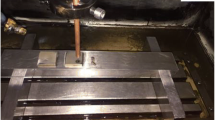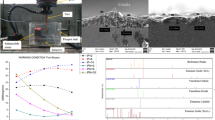Abstract
Adding Al and Al2O3 powder creates electrical discharge machining (EDM) in a significant machining gap with stable condition. Practically, it is almost impossible to distribute powder particles evenly into the plasma channel. This study investigates the intermolecular process while the plasma channel’s pressure and temperature are changed. In our research, surfactant Tween 80® and its effects on intermolecular forces (IMF) through the plasma channel were investigated to evaluate surface quality. In the first phase of our research, output parameters ran at three experimental blocks (without surfactant, with 21.81 g/l of surfactant, and 43.3512 g/l of surfactant) in 17 runs while adding Al and Al2O3 powders with the design of experience (DOE) method by Design Expert software. Decomposition phenomena (DP), adhesion phenomena (AP), and nonuniform distribution (NUD) of Al and Al2O3 powders demonstrated how new molecules (aluminum trihydride, aluminic acid, methyl(methylene)aluminum, hydroxy(methyl)aluminum hydride, hydroxy(methylene)aluminum, and methyl(oxo)aluminum) were created on the surface element composition. In our experiment, powders’ even distribution when we decomposed Al and Al2O3 created a more stable plasma channel. Consequently, it led to a more balanced heat transfer on the electrodes’ surface. We used scanning of surface quality by field emission-scanning electron microscopy (FE-SEM), electron dispersive spectrum (EDS), and mapping and have shown how to improve the surface defects (hole, crack, and globule). In the second phase of our research, we investigated the intermolecular forces (IMF) on Al–O bond and Al–Al bond. The percentage of elements obtained by mapping analysis of cross-section illustrated that oxygen and aluminum had increased notably when we used Al powder. Considering physical, chemical, metallurgical, and machining time management (MTM) of PM-EDM, we demonstrated that the fine finishing surface improved by 217.7% at Ip = 15 A and Ton = 50 μs and Cp = 5 g/l when the surfactant was added. We compared the best-optimized points in the final phase of our work and measured the recast layer thickness (RLT) after adding Al and Al2O3. As a result, the RTL was removed entirely when Al was added to the dielectric. We have shown that MRR (g/h) and TWR (g/h) were decreased by 5.23 and 113.36%, and SR (Ra) and machining time were increased by 21.75 and 50.84%, respectively. We note that high strength-to-weight ratio and corrosion resistance are essential for many industries, particularly aerospace and biomedical industries. We believe that these industries can potentially benefit from our study.






























Similar content being viewed by others
Data availability
Not applicable
References
Philip JT, Mathew J, Kuriachen B (2021) Transition from EDM to PMEDM – impact of suspended particulates in the dielectric on Ti6Al4V and other distinct material surfaces: a review. J Manuf Process 64:1105–1142
Ali Mahdavinejad R, Asghari Ilani M (2019) Superior advance research in the electro-discharge machining of Ti alloys: review. Int J Sci Res Mech Mater Eng 3:19–38. https://doi.org/10.32628/IJSRMME19339
Ilani MA, Khoshnevisan M (2021) Mathematical and physical modeling of FE-SEM surface quality surrounded by the plasma channel within Al powder-mixed electrical discharge machining of Ti-6Al-4V. Int J Adv Manuf Technol 112:3263–3277. https://doi.org/10.1007/s00170-021-06626-1
Ilani MA, Khoshnevisan M (2020) Powder mixed-electrical discharge machining (EDM) with the electrode is made by fused deposition modeling (FDM) at Ti-6Al-4V machining procedure. Multiscale Multidiscip Model Exp Des:1–14. https://doi.org/10.1007/s41939-020-00070-6
Tang J, Yang X (2018) Simulation investigation of thermal phase transformation and residual stress in single pulse EDM of Ti-6Al-4V. J Phys D Appl Phys 51:135308. https://doi.org/10.1088/1361-6463/aab1a8
Hemmasian Ettefagh A, Zeng C, Guo S, Raush J (2019) Corrosion behavior of additively manufactured Ti-6Al-4V parts and the effect of post annealing. Addit Manuf 28:252–258. https://doi.org/10.1016/j.addma.2019.05.011
HuuPhan N, Muthuramalingam T, Vu NN, Tuan NQ (2020) Influence of micro size titanium powder-mixed dielectric medium on surface quality measures in EDM process. Int J Adv Manuf Technol 109:797–807. https://doi.org/10.1007/s00170-020-05698-9
Phan NH, Pi VN, Tuan NQ et al (2021) Tool wear rate analysis of uncoated and AlCrNi coated aluminum electrode in EDM for Ti-6Al-4 V titanium alloy. Lecture Notes in Networks and Systems. Springer Science and Business Media Deutschland GmbH, pp 832–838
Haque R, Sekh M, Kibria G, Haidar S (2021) Comparative study of parametric effects on the performance of simple and powder mixed EDM using aluminium and graphite powder on Inconel X750 alloy. Mater Today Proc. https://doi.org/10.1016/j.matpr.2021.03.419
Sahu RK, Hiremath SS (2017) Synthesis of aluminium nanoparticles in a water/polyethylene glycol mixed solvent using μ-EDM. In: IOP Conference Series: Materials Science and Engineering. Institute of Physics Publishing, p 012257
Patel S, Thesiya D, Rajurkar A (2018) Aluminium powder mixed rotary electric discharge machining (PMEDM) on Inconel 718. Aust J Mech Eng 16:21–30. https://doi.org/10.1080/14484846.2017.1294230
Zhang Y, Liu Y, Shen Y et al (2012) A review of the current understanding and technology of powder mixed electrical discharge machining (PMEDM). In: 2012 IEEE International Conference on Mechatronics and Automation. ICMA 2012:2240–2247
Assarzadeh S, Ghoreishi M (2013) A dual response surface-desirability approach to process modeling and optimization of Al2O3 powder-mixed electrical discharge machining (PMEDM) parameters. Int J Adv Manuf Technol 64:1459–1477. https://doi.org/10.1007/s00170-012-4115-2
Kumar H (2015) Development of mirror like surface characteristics using nano powder mixed electric discharge machining (NPMEDM). Int J Adv Manuf Technol 76:105–113. https://doi.org/10.1007/s00170-014-5965-6
MangapathiRao K, Vinaykumar D, Chandra Shekar K, Kumar RR (2021) Investigation and analysis of EDM process – a new approach with Al 2 O 3 nano powder mixed in sunflower oil. IOP Conf Ser Mater Sci Eng 1057:012059. https://doi.org/10.1088/1757-899x/1057/1/012059
Jabbaripour B, Sadeghi MH, Shabgard MR, Faraji H (2013) Investigating surface roughness, material removal rate and corrosion resistance in PMEDM of γ-TiAl intermetallic. J Manuf Process 15:56–68. https://doi.org/10.1016/J.JMAPRO.2012.09.016
Al-Amin M, Abdul Rani AM, Abdu Aliyu AA et al (2020) Powder mixed-EDM for potential biomedical applications: a critical review. Mater Manuf Process 1–23
Singh R, Dvivedi A, Kumar P (2020) EDM of high aspect ratio micro-holes on Ti-6Al-4V alloy by synchronizing energy interactions. Mater Manuf Process 35:1188–1203. https://doi.org/10.1080/10426914.2020.1762207
Phan NH, Pi VN, Shirguppikar S et al (2021) Material removal rate in electric discharge machining with aluminum tool electrode for Ti-6Al-4V titanium alloy. Lecture Notes in Networks and Systems. Springer Science and Business Media Deutschland GmbH, pp 527–533
Hosni NAJ, Lajis MA (2019) Multi-response optimization of the machining characteristics in electrical discharge machining (EDM) using span-20 surfactant and chromium (Cr) powder mixed. Mater Werkst 50:329–335. https://doi.org/10.1002/mawe.201800204
Kolli M, Kumar A (2017) Surfactant and graphite powder–assisted electrical discharge machining of titanium alloy. Proc Inst Mech Eng Part B J Eng Manuf 231:641–657. https://doi.org/10.1177/0954405415579019
Kumar R, Roy S, Gunjan P et al (2018) Analysis of MRR and surface roughness in machining Ti-6Al-4V ELI titanium alloy using EDM process. Procedia Manufacturing. Elsevier B.V, pp 358–364
Das S, Paul S, Doloi B (2019) Application of CFD and vapor bubble dynamics for an efficient electro-thermal simulation of EDM: an integrated approach. Int J Adv Manuf Technol 102:1787–1800. https://doi.org/10.1007/s00170-018-3144-x
Aggarwal A, Kumar A (2019) Finite element analysis of melt pool characteristics in selective laser spot melting on a powder layer. In: 3D Printing and Additive Manufacturing Technologies. Springer Singapore, Singapore, pp 1–13
Fazli Shahri HR, Mahdavinejad R, Ashjaee M, Abdullah A (2017) A comparative investigation on temperature distribution in electric discharge machining process through analytical, numerical and experimental methods. Int J Mach Tools Manuf 114:35–53
Yue X, Yang X (2015) Molecular dynamics simulation of the material removal process and gap phenomenon of nano EDM in deionized water. RSC Adv 5:66502–66510. https://doi.org/10.1039/c5ra11419e
Taherkhania A, Asghari Ilani M, Ebrahimi F, et al (2021) Investigation of surface quality in cost of goods manufactured (COGM) method of μ-Al2O3 powder-mixed-EDM process on machining of Ti-6Al-4V. https://doi.org/10.21203/rs.3.rs-297047/v1
Dhadda G, Hamed M, Koshy P (2021) Electrical discharge surface texturing for enhanced pool boiling heat transfer. J Mater Process Technol 293:117083. https://doi.org/10.1016/j.jmatprotec.2021.117083
Quarto M, D’Urso G, Giardini C, Maccarini G (2020) FEM model development for the simulation of a micro-drilling EDM process. Int J Adv Manuf Technol 106:3095–3104. https://doi.org/10.1007/s00170-019-04750-7
Acknowledgements
I have always immensely benefited from Professor Sergey Kravchenko’s academic support at Northeastern University, Department of Physics in the United States of America, and I would like to express my sincere appreciation and most profound gratitude for his academic support and encouragement. Affiliated Research Professor Mohammad Khoshnevisan Physics DepartmentCollege of Science Northeastern University, Boston, MA 02115, United States of America.
Author information
Authors and Affiliations
Contributions
Mohsen Asghari Ilani carried out the experiments. Mohammad Khoshnevisan contributed to the analysis of the results and writing the paper. Both authors read and approved the final manuscript.
Corresponding author
Ethics declarations
Ethics approval
Not applicable
Consent to participate
Not applicable
Consent for publication
Not applicable
Competing interests
The authors declare no competing interests.
Additional information
Publisher’s note
Springer Nature remains neutral with regard to jurisdictional claims in published maps and institutional affiliations.
Rights and permissions
About this article
Cite this article
Ilani, M.A., Khoshnevisan, M. Study of surfactant effects on intermolecular forces (IMF) in powder-mixed electrical discharge machining (EDM) of Ti-6Al-4V. Int J Adv Manuf Technol 116, 1763–1782 (2021). https://doi.org/10.1007/s00170-021-07569-3
Received:
Accepted:
Published:
Issue Date:
DOI: https://doi.org/10.1007/s00170-021-07569-3




